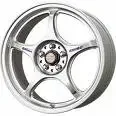Inertia is a measure of a give bodies resistance to rotation. I'm going to have to refresh myself on a bit of calculus to figure stuff out for something of a non-uniform density (IE: more mass near the center of the body), and I can probably post on that later, but let's take a look at a few basic formulas.
Rotation of a cylinder about it's central axis has the following formula:
I = 1/2 mr^2
Rotation of a thin cylindrical shell (hollow center) with negligible thickness has the following formula:
I = mr^2
Rotation of a cylindrical (hollow center) shell with a non-negligible thickness has the following formula:
I = 1/2m(R1^2 + R2^2) where R1 is the inner radius and R2 is the outer radius.
m, mass, is the least significant term in these equations. Every time mass of the rotating body, the value of I increases linearly. IE: m = 1, r = 1 for a cylinder:
I = 1/2mr^2
I = 1/2(1)(1^2)
I = 1/2
IE: m = 2, r = 1
I = 1/2mr^2
I = 1/2(2)(1^2)
I = 1
r, radius, is the most significant term. Every increase of R will increase the value of I at a squared rate. IE: m = 1, r = 2 for a cylinder:
I = 1/2mr^2
I = 1/2(1)(2^2)
I = 2
What does this mean? More mass, more inertia, more resistance to twisting force (acceleration, braking). More radius, a LOT more inertia, etc etc. But... we don't really change our total tire + wheel radius by very much, do we? 1 or 2% maybe, depending on tire size. What changes the most is total weight, and usually not by more than maybe 15 - 20%. It'll change the moment of inertia, but not by a hugely significant amount. As it stands, the third formula I've posted is the nearest to the actual problem, because a wheel and tire still have most of the weight near the outside of the tire. It gets more complicated to calculate inertia of a cylinder with an effectively non-uniform weight distribution, and if I can brush up on my university physics enough to make a decent explanation of it, I will later.
Long and the short of it, you'll see positive performance gains in all areas of the vehicles performance, and it is a lightening of unsprung mass, but they may not be as significant as you think. A 20% less heavy wheel will have approximately a 20% lower moment of inertia. How much effective HP this works out to, I have no idea.


